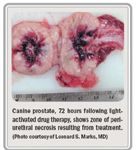Article
Study: Light-activated BPH therapy safe, painless
Author(s):
Light-activated drug therapy for BPH has been shown to be safe and painless in a phase I/II trial.

Key Points
Chicago-Light-activated drug therapy for BPH has been shown to be safe and painless in a phase I/II trial, the results of which were presented at the AUA annual meeting.
The therapy, formerly called Litx and now known as Aptocine, uses light-emitting diodes (LEDs) to activate talaporfin sodium. The drug then produces singlet oxygen in exposed tissue, leading to localized cell death.

"However, commercial success has been limited because of the high cost and operational difficulties of lasers, which have been the only light sources used with light-activated drugs until the advent of the LEDs packaged with this system."
Talaporfin treatments employ a single-use Foley catheter with a 10-mm array of LEDs (wavelength 664±5 nm). In the preclinical study, the catheter was placed in dogs under general anesthesia, and talaporfin at 25 mg/kg was administered intravenously.
Results in human subjects
In the six men, only intraurethral lidocaine was required to place the catheter. Patients received talaporfin intravenously at 1 mg/kg. All men were treated in an office setting.
Two- and 7-day necropsy in the canine subjects revealed a dose-dependent kill zone of 20% to 25% of prostate volume surrounding the urethra. The researchers reported that the urothelium was "relatively spared, and the treatment effect was confined to the prostate" with no urinary retention.
Among humans, treatment was said to be painless, with all patients voiding spontaneously through 3-month follow-up. Cystoscopy at 2 weeks and 3 months showed that urothelium appeared normal, with little change seen on transrectal ultrasound.
There were modest improvements in International Prostate Symptom Score and Qmax among the six men, which would suggest the use of higher doses of energy in later studies.
In fact, Dr. Marks and colleagues have already begun to treat patients using higher doses.
"After safety was established at doses that were likely to be sub-therapeutic, the doses now being used are likely to produce therapeutic results while remaining safe," Dr. Marks said. "Very early indications are that this is the case."
Presently, talaporfin is being used in men for whom oral therapies have been unsuccessful. Dr. Marks noted that, depending on data from current trials, the treatment "might be expanded to include men recently diagnosed with BPH or those who have lived with BPH for some time, but who have refused drug treatment because of potential side effects."
In addition to being the principal investigator for the phase I/II study of talaporfin in BPH, Dr. Marks has actively advised Light Sciences Oncology, the drug's manufacturer, on protocols for further trials.















